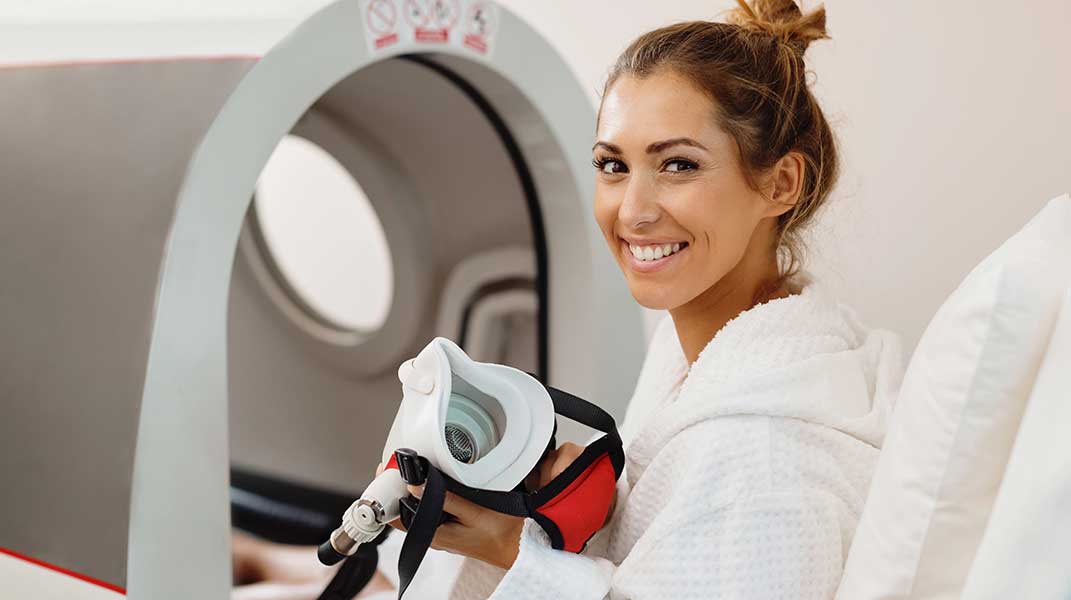
14 Oct 3 Medical Conditions That HBOT Treats
Hyperbaric oxygen therapy, or HBOT, involves breathing pure oxygen in a pressurized environment. This therapy is a well-established treatment for certain medical conditions and is a key tool in functional medicine. The increased air pressure allows your lungs to gather more oxygen than would be possible at normal air pressure. Your blood then carries this oxygen throughout your body. Here is information on three conditions where HBOT is used as a therapeutic approach:
Chronic Wounds
Chronic wounds can be particularly challenging. These are sores that don’t heal as expected, and conditions like diabetic foot ulcers are a common example. When standard treatments aren’t enough, Hyperbaric Oxygen Therapy (HBOT) can offer a valuable addition to a comprehensive functional medicine healing plan.
Here’s how HBOT helps promote the healing of chronic wounds:
- Boosts Oxygen Levels: HBOT significantly increases the amount of oxygen dissolved in your blood plasma. This is pivotal because many chronic wounds suffer from a lack of adequate oxygen, hindering their ability to repair.
- Stimulates Healing Factors: The elevated oxygen levels encourage your body to release key substances like growth factors and stem cells. These are needed for repairing damaged tissue and fostering the development of new, healthy skin and underlying tissues.
- Supports Natural Repair: By delivering a higher concentration of oxygen directly to the affected tissues, HBOT actively supports your body’s natural healing processes. This is especially beneficial for wounds that struggle to mend due to issues like poor circulation or persistent inflammation.
HBOT creates an optimal environment for healing, especially for wounds that have been resistant to other treatments. It empowers your body to overcome the underlying challenges preventing proper wound closure, helping you move closer to recovery.
Infections
When Antibiotics Aren’t Enough
Certain infections can be challenging to treat with antibiotics alone, especially those that thrive in low-oxygen environments or cause tissue death. In these cases, hyperbaric oxygen therapy (HBOT) is used as a supportive treatment alongside antibiotics and surgical debridement.
How HBOT Fights Infections
HBOT creates a high-pressure oxygen environment that makes it harder for anaerobic bacteria—germs that don’t need oxygen to survive—to grow and produce toxins.
Boosting the Body’s Immune Response
The therapy also enhances the ability of white blood cells to kill bacteria, strengthening the immune system while promoting tissue recovery. This dual effect helps manage severe infections more effectively.
Hearing Loss
Sudden sensorineural hearing loss, sometimes called sudden deafness, is an unexplained, rapid loss of hearing. It can happen all at once or over several days. While the exact cause is often unknown, it is sometimes linked to viral infections, circulatory problems, or trauma to the inner ear. For some individuals experiencing this condition, prompt medical attention is necessary.
HBOT may be recommended as a treatment for sudden hearing loss, often in combination with other therapies like corticosteroids. The theory is that the increased oxygen supply can help reduce inflammation and swelling in the inner ear. It may also help revive damaged hair cells in the cochlea, which are responsible for hearing. The therapy aims to restore function to parts of the ear affected by a lack of oxygen.
Consult a Functional Medicine Provider
Understanding the applications of HBOT can help you have a more informed discussion with your healthcare provider. If you are exploring treatment options for a complex health issue, a functional medicine provider can offer a comprehensive perspective. They focus on identifying and addressing the root cause of disease. A consultation can help determine if this or other therapies fit within your personalized health plan. Discuss your health history and goals to see what approach is right for you.

No Comments